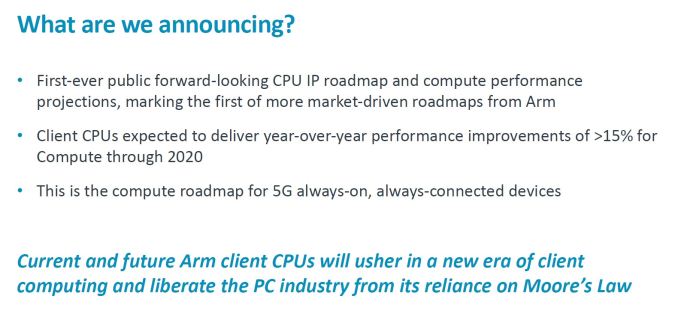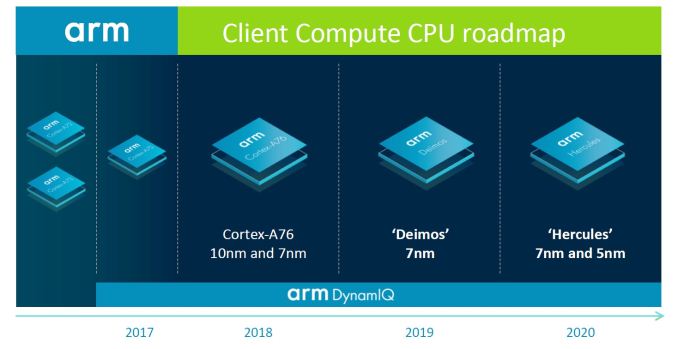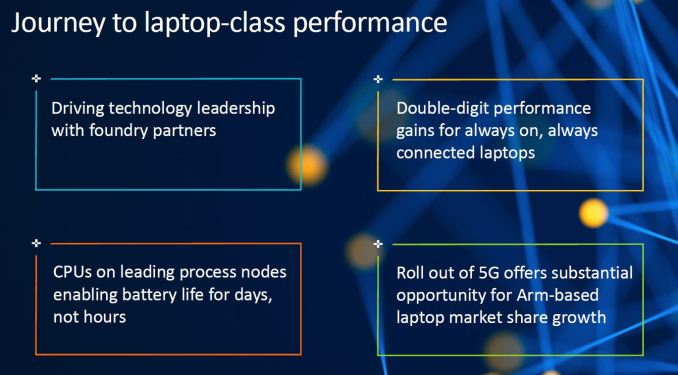Arm Unveils Client CPU Performance Roadmap Through 2020 - Taking Intel Head On
by Andrei Frumusanu on August 16, 2018 9:05 AM EST
Today’s announcement is an oddball one for Arm as we see the first-ever public forward looking CPU IP roadmap detailing performance and power projections for the next two generations through to 2020.
Back in May we extensively covered Arm’s next generation Cortex A76 CPU IP and how it’s meant to be a game-changer in terms of providing one of the biggest generational performance jumps in the company’s recent history. The narrative in particular focused on how the A76 now brought real competition and viable alternatives to the x86 market and in particular how it would be able to offer performance equivalent to Intel’s best mobile offerings, at much lower power.
Arm sees always-connected devices with 5G connectivity as a prime opportunity for a shift in the laptop market. Qualcomm’s recent Snapdragon 835 and Snapdragon 850 platforms were the first attempts in trying to establish this new slice for Arm-based PCs.
Today’s roadmap now publicly discloses the codenames of the next two generations of CPU cores following the A76 – Deimos and Hercules. Both future cores are based on the new A76 micro-architecture and will introduce respective evolutionary refinements and incremental updates for the Austin cores.
The A76 being a 2018 product – and we should be hearing more on the first commercial devices on 7nm towards the end of the year and coming months, Deimos is its 2019 successor aiming at more wide-spread 7nm adoption. Hercules is said to be the next iteration of the microarchitecture for 2020 products and the first 5nm implementations. This is as far as Arm is willing to project in the future for today’s disclosure, as the Sophia team is working on the next big microarchitecture push, which I suspect will be the successor to Hercules in 2021.
Part of today’s announcement is Arm’s reiteration of the performance and power goals of the A76 against competing platforms from Intel. The measurement metric today was the performance of a SPECint2006 Speed run under Linux while complied under GCC7. The power metrics represent the whole SoC “TDP”, meaning CPU, interconnect and memory controllers – essentially the active platform power much in a similar way we’ve been representing smartphone mobile power in recent mobile deep-dive articles.
Here a Cortex A76 based system running at up to 3GHz is said to match the single-thread performance of an Intel Core i5-7300U running at its maximum 3.5GHz turbo operating speed, all while doing it within a TDP of less than 5W, versus “15W” for the Intel system. I’m not too happy with the power presentation done here by Arm as we kind of have an apples-and-oranges comparison; the Arm estimates here are meant to represent actual power consumption under the single-threaded SPEC workload while the Intel figures are the official TDP figures of the SKU – which obviously don’t directly apply to this scenario.
We didn’t have internal data to verify Arm’s claims as of publishing of the article, but the 15W Intel figure is naturally on the high side, given that this just the official TDP representing multi-threaded workloads – a very quick test of CB15 ST power as reported by MSR registers on an 7200U at 3.1GHz measured 9.3W package+DRAM power while an 8250U at 3.35GHz came in at 11W. I haven’t correlated SPEC power on x86 to date, but I’m expecting it on average to be less than CB15. Even if the 15W figure for the 7300U is correct, and I’m expecting something more in the range of 9-11W, Arm might be using one of Intel’s notably less efficient performance points when doing the comparison for these SKUs. Of course this doesn’t invalidate the data as efficiency for the A76 at those frequencies would also not be optimal, it’s just something to keep in mind.
It’s also interesting to see Arm scale back on the performance comparison as they’re using a 3GHz A76 as the comparison data-point – this is in contrast to the 3.3GHz maximum 5W performance point presented during TechDay. I had tried to estimate the A76’s power in mobile form-factors based on the different metrics Arm disclosed and came at an estimated 2.3W at 3GHz. Naturally Arm says “less than 5W” and they could be erring on the safe side of not over-promising – but if it had been *that* much lower, as in my estimate, we would have maybe seen even more aggressive marketing figures. In the end, until we get the first A76 devices in our hands, we won’t know for sure what the exact figures will be and at which point on the efficiency curve Arm’s projected 3GHz performance figures will end up at.
The last slide that is notable to talk about is the performance projections for Deimos and Hercules. Here Arm’s taking a direct stab at Intel’s lack of significant progress over the last few years and reiterating its confidence in the company’s ability in sustaining high CAGR (compound annual growth rate) performance figures for the next generations.
Again at TechDay we quoted figures of 20-25% while today’s announcement contained a more conservative figures of “>=15%” – likely better representing a seemingly larger 20% projected boost for Deimos as well as what seems to be a 10% gain for the 5nm follow-up Hercules. Taking into account the relative positioning of the data-points in this chart, I did some quick correlation and it matches my initial estimated performance figures for a 3GHz A76 at around ~26 SPECint2006. Deimos and Hercules would come in at figures of ~31 and ~34 points.
Finally today’s announcement is a marketing exercise attempting to emphasise Arm’s performance and power commitments over the next few generations, trying to showcase it has the strategy and technology in place to make the Arm laptop market a real growth opportunity. If and how this pans out is something that we won’t find out at least until later on in the year, with the first actual A76 based large form-factor designs not being a thing until at least sometime in 2019. We’re eagerly awaiting the first A76 based mobile designs in the months to come and to have a first hand-on evaluation of the new microarchitecture family.















102 Comments
View All Comments
rocky12345 - Thursday, August 16, 2018 - link
Yea I think I tried to just say x86 as a whole since there is Intel & AMD to look at here. As others have also stated AMD & Intel won't be sitting still while ARM tries to release these magical CPU's that from their own slides is showing Intel's older low performance,low power chips that are also only dual core CPU's. They very much know they can not compete with Intel or AMD on the high end sector or they would have shown full desktop CPU's from Intel or AMD in their slides which they did not because they no that right now and in the future to be on the same performance level is only a pipe dream for them.I personally would never buy a PC based on a ARM CPU with Windows for the reason that it will be very much useless to me and very slow with the software and games I run & I do not want to have performance that I had a decade ago from Intel/AMD on my shiny new PC in 2020. Maybe for basic tasks and internet surfing such as Facebook,Twitter etc these ARM CPU's will work fine but for any serious work or play you want the tried and true AMD/Intel x86 CPU under the hood.
HStewart - Thursday, August 16, 2018 - link
Agree,,,But I think Microsoft would have "Windows on ARM" or more specifically "Windows on Snapdragon" or "Windows on Qualcomm" because they would love to get rid of legacy so they are dependent on x86 based code - both Intel and AMD depending customer preferences.
But I think this is a Microsoft Pipe dream just as Windows 10 S and Windows RT ( which is closer to Windows for ARM ). I have yet to see any evidence of Windows for ARM outside possibly Amazon. HP had best score on there - because probably uses stuck with Windows 10 S applications - I can see it being good for that - and that might Microsoft primary Goal.
close - Friday, August 17, 2018 - link
@HStewart - "There have been rumors of Apple ditching Intel floating on Internet for 6 to 10 year"You're saying that 2 years after Apple switched to Intel there were rumors that they will drop them?
In favor of what, AMD CPUs which at the time were slower and less efficient than Intel's? Or for ARM CPUs that at the time had almost 0 traction? 6 years ago there were "reports". 10 years ago they weren't rumors, they were a guy posting on a forum maybe.
rocky12345 - Thursday, August 16, 2018 - link
I think the problem ARM and the likes will face is that x86 is firmly planted into the eco system it won't be going any where any time soon. Besides that if ARM even wants to think about getting a foot hold into the PC industry and try to take on Intel & AMD they need to have actual software that can match what is already on the PC desktop x86 platform which will take years to get there and even then they have to think a lot bigger than they are now.Applets will not cut it on the desktop platform even though Microsoft is trying hard to go that route with their MS store and the ton of crap Applets that are in there. No one that wants to get any real work done wants to use a half baked 2MB Applet that is lacking in features when you also have a choice of getting a full fledged software program that has all of the features baked into it and you do not need to use 5 or 10 Applets to get the same job done.
ARM needs way faster cores at least 50% faster so they can emulate x86 and hope to do it at the same speed as a x86 CPU can. I do not care that Linux can run ARM code even though it is a good OS it does not have the market share to even make a dent in the market. Now with Microsoft pushing for ARM into their Windows platform yes it will speed things up some what but you still have to deal with almost useless Applets that are rather lacking.
Alot of this is also kinda mute because we have a lot fo the industry now pushing for cloud everything including MS and to have everything subscription based. This allows them to control every aspect of the software and your PC as well. If you miss a payment your PC may stop functioning until you renew your subscription windows will most likely be subscription based by 2022 and you might be able to still buy a full copy of windows but it will be costly and probably lacking most of the features or have ad's every where if they do it for free. I think that day is for sure coming Bill Gates back in the mid 90's as much as said it was the way he envisioned the windows platform going by the early 2000's well we are here in the early 2000's and it looks like he may have been right.
Wilco1 - Thursday, August 16, 2018 - link
"ARM needs way faster cores at least 50% faster so they can emulate x86"Where on earth do you get that idea from? Windows runs 100% native on Arm and so are practically all applications that most people actually use. Emulation of some old x86 code is not the primary use case, but it's great it exists and works transparently when you happen need it.
rocky12345 - Thursday, August 16, 2018 - link
If they want to get past the front door yes they have Microsoft hand holding them with OS support for the ARM based CPU's and soon maybe Apple as well depending on if Intel tries to play ball with Apple or not. x86 based programs out number anything ARM will have on the desktop for a very long time so they need to be up to speed.I also found it funny that when they showed off those slides for what was it 2020 they were showing their CPU projections and had a i5 7300U dual core with hyper threading. This is one of Intel's slowest CPU's but hey they plan on beating it by 2020 yay. Mean while both Intel & AMD have CPU's on the desktop now that are 70-90 times faster than that crusty slow i5 7300U. Heck even in the laptop world both AMD and Intel have CPU's that are leagues faster now yes they use more power but I would prefer having a CPU that can run my stuff very fast and use a bit of power to do it than sit waiting for hours to get the same job done. It is going to happen whether people like me want it to or not for the most part the computer industry has gotten very stupid in the last 5-6 years and we have always found ways to get through the stupid and will with this as well. I think I most hate the thought of having to work on these machines for my customers I hate slow with a passion.
Wilco1 - Thursday, August 16, 2018 - link
The slide clearly shows Cortex-A76 beating i5-7300u in 2018 on single-threaded performance. Yes that is this year. So which CPU has 100 times the single-threaded performance of i5-7300u???Dual-socket Arm CPUs with 256 threads are being sold already if you wanted something that has higher performance than high-end Xeons.
rocky12345 - Friday, August 17, 2018 - link
And yet if you take those ARM cores run x86 emulation on them because you need a certain type of software that is not available on the ARM platform those Xeon's will be more than happy to out run those ARM cores choking on x86 code and the Xeon's will do it gracefully and with ease because that's what they were made to do.I do not hate ARM they have good designs the problem is them trying to show their CPU's as fast as a Intel/AMD CPU in everything when clearly they won't be because x86 software has like what 99% of the market with 1000's upon 1000's of programs made for it. Sorry but the ARM platform has to be able to support those programs as well because that is where the market has been and is at right now and will be into the future as well. If they can not run these 1000's of programs as well as their competition then they already lost. Yes there will be software made for their CPU's and already has been but that software is not even in the .5% bracket.
Yes there will be a lot of people that just want to surf the internet or look at You tube videos or look at their pictures etc and I guess for now these ARM CPU's will serve them well but for everyone else we have much bigger and faster CPU's to serve us gamer's come to mind you can bet your bottom dollar a gamer will not be willing to lose even 1 FPS in their game if they were forced to switch to a ARM CPU.
Wilco1 - Sunday, August 19, 2018 - link
There is no use case for emulation on servers. Software is recompiled and run natively. It's a non-trivial task of course but it has already been done for most server code.You know you can recompile software, right? High level language are a thing you know. People don't write software for a specific CPU since, well 4-5 decades now. So all popular software is recompiled for Arm.
What's left (unpopular and rarely used older applications) can be emulated. But saying you've lost unless you can beat the fastest x86 CPUs while emulating is absolutely ridiculous. All it needs is run fast enough, and the existing Windows on Arm laptops are pretty much there already.
dudedud - Thursday, August 16, 2018 - link
"Emulation of some old x86 code is not the primary use case"Chrome is not old... and i dont think all apps from the Microsoft store are ARM compiled.